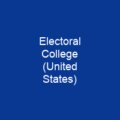The Electoral Count Act of 1887 is a federal law establishing procedures for the counting of electoral votes by Congress following a presidential election. The law was enacted in the aftermath of the disputed 1876 presidential election, in which several states submitted competing slates of electors. It has been criticized since it was enacted, with an early commenter describing it as “very confused, almost unintelligible” The central provisions of the law have not been seriously tested in a disputed election.
About Electoral Count Act in brief

Under the law, while Congress claimed full power to validate votes, its role was limited to cases in which a state had failed to settle its own disputes and questions beyond state competence to settle the issue. In 1865, Congress asserted total power over the electoral vote. In 1875, the House was controlled by Democrats in 1875 for the first time since war, with a greater sensitivity toward states’ rights. After the 1876 Hayes-T-Tilden crisis, the Act was eventually enacted in 1887 as a compromise measure in an atmosphere of partisan pressures. It gives the states an initial opportunity to finalize their own controversies regarding the electors, before its final determination is made. The electors are appointed at the national election held on Election Day. After Election Day, the electors chosen in each state must then give their votes on the first Monday after the second Wednesday in December, with meetings of electors typically held in eachState capital. The Twelfth Amendment ratified in 1804 requires the electors to make distinct lists of all persons voted for as President, and of. all persons votes for as Vice-President, and. of the number of votes for each, which lists they shall sign and certify, and transmit sealed to the seat of the government of the U.S., directed to the President. : 328 Enacted by strong Republican majorities in the wake of the Civil War, the rule provided simply that if any question arose about a state’s electoral votes, the affirmative consent of both the House or Senate was required before the state’s votes would be count.
You want to know more about Electoral Count Act?
This page is based on the article Electoral Count Act published in Wikipedia (as of Dec. 18, 2020) and was automatically summarized using artificial intelligence.







